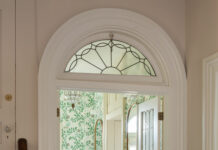 On a grey summer morning, Jonna Lazarus, landscape designer and owner of Lazarus Design Associates LLC, drives through the streets that form the campus of the Maryland Institute College of Art (MICA). “This is where it all began,” she says pulling over in front of the marble 1908 Renaissance Revival Main Building. “One day in 1984 Fred asked me what I’d do here. Big yews masked the architectural detail.”
On a grey summer morning, Jonna Lazarus, landscape designer and owner of Lazarus Design Associates LLC, drives through the streets that form the campus of the Maryland Institute College of Art (MICA). “This is where it all began,” she says pulling over in front of the marble 1908 Renaissance Revival Main Building. “One day in 1984 Fred asked me what I’d do here. Big yews masked the architectural detail.”
Fred, of course, is her husband Fred Lazarus IV, who just retired in May after a monumental 36-year term as president of MICA. Under his leadership MICA
became one of the country’s leading art colleges and revitalized the neighborhoods around it. Early on, Jonna gave him a few suggestions for the Main Building, then soon became not only his armchair counsel on landscape design but also an official MICA contractor instrumental in the transformation of the campus.
While she continued her work with other residential and educational clients, Jonna brought to MICA years of design expertise: a degree in art, interior design and business from Rochester Institute of Technology, three years as home furnishings fashion director at Carson Pirie Scott in Chicago, a graduate certificate in landscape design from George Washington University and eight years with landscape architects Crozier Associates in Baltimore.
In 1984 though, she had no idea that during her husband’s tenure MICA would expand to 28 buildings. She also had no idea that she, guided by master planning by Ayers Saint Gross, would be the one to design and create green spaces and gardens to unify the buildings as a handsome urban campus.
Jonna integrated each building acquisition by adding gardens with colorful but tastefully painted walls as occasional backdrops, lighting, terraces and amenities like fountains, tables, chairs and benches. At a tiny corner garden near the Station Building, she points out modern, U-shaped bike racks. “What started as a few mushroomed. It’s thrilling the racks now are all full all of the time,” she says.
The plantings here—a native serviceberry tree, gold mound spirea, silver sceptre sedge—repeat in other gardens. Three repurposed semi-circular stones function as sculpture and sitting spots. “We do that a lot,” she says of the recycled stones.
The approximate total of five acres Jonna has designed tie together a campus of diverse architecture. Buildings range from late 19th century structures, like the renovated B & O Mount Royal Station, to mid-20th century modern buildings like the Bunting Center (formerly the AAA building) to contemporary structures like the Brown Center, The Gateway and recently opened Leake Hall.
More than two-dozen outdoor spaces carry Jonna’s signature style, plantings and palette. Some, like Sally’s Garden, are as small as large school sandboxes. Others, like Pearlstone Park and Founders Green, are as big as city parks. Together they wind north and south, from Preston Street to North Avenue, east and west from Maryland Avenue to Park Avenue, like green ribbons embroidered with refined and striking colors.
Lazarus’ design concept is simple: plantings that look good all year, especially from September to May when the students are on campus. “And continuity too, now that we have created a broad plant palette,” she adds. Plant continuity and repetition unite a multitude of spaces. Repetition of fixtures and hardscape materials also enhance gardens, buildings, streets and even parking lots.
“I try to use as many natives as possible, as well as hardy plant material, both drought and city tolerant,” she says. Among hundreds of trees she has planted, most are natives: sweet bay magnolias, serviceberries, sweet-smelling lindens, delicate-leafed willow oaks, sugar and red maples with brilliant fall foliage, multi-stemmed river birches that look themselves like sculpture.
Under the trees, along walls, by entrances and as punctuation in park-like greens, Lazarus layers shrubbery the way residential gardeners cluster perennials. Among her favorites are durable spirea with gold or green foliage and pale pink blooms, chartreuse and red barberry in varieties not invasive in the city, slow-growing yews for texture, disease-resistant evergreen American boxwoods and Japanese hollies, all types of viburnums, even the leatherleaf variety as screening near an expressway ramp.
“If we use perennials, they’re ones that look good a long time,” she says. Hellebores, for example, are in shady spots as under white crape myrtles in the geometry- filled inner courtyard of the Robert and Jane Meyerhoff House. Black-eyed Susans and Russian sage thrive in sunny spots at The Gateway where layered gardens and a fountain showcase Jonna’s artistry.
Perennial grasses waft through the campus. Tall varieties create graceful movement and seasonal interest from the intimate “Sally’s Garden,” to the spacious, open gardens at Founders Green Residential Complex. Low-growing varieties, like mondo grass, work as ground cover in heavily trafficked spots or places hard to mow like the steep hillsides by North Avenue.
Lazarus’ color palette runs from deep crimson and lavender to contrasting and eye-popping chartreuse to pink, silver and white, with occasional flickers of yellows and reds.
“And lighting is important to us,” she says. Besides downwardly directed lamps and period street fixtures, lighting appears in subtle places: the underside of a stainless steel railing, signature short bollards along plazas and sidewalks, directed tubes of light washing walls. All add safety and aesthetics but not light pollution.
“Most of the sculpture was here,” she says driving past Paul Daniel’s turning Babette. “We just added plants.” Plants, like the golden-leaf staghorn sumac by Daniel’s piece, compliment and anchor the sculpture.
Besides giving beauty and continuity, the many new outdoor spaces increase quality of campus life. Although the college students are gone, city school children pour from the Brown Center and run across the green, garden-surrounded Cohen Plaza, once a parking lot. “See the fountain?” Lazarus asks as children stream past it. “My former partner Julie Higgins saw that it was out of whack. We had to jackhammer it after it was poured and move it, not much, but to make everything look right.” Such is the precision of the eyes that have transformed these urban acres.
And such is MICA’s commitment to landscape architecture. “Luckily, MICA takes seriously the maintenance of the grounds,” Jonna says. Her phone rings constantly. Two calls are from nurserymen, the third about a downed tree limb. In every area maintained by MICA, trees and shrubs are well-pruned, garden beds are weeded. No trash litters the street. “The only challenge is power pruners,” she says. “We like hand pruning.”
Passing the former Jos. A. Bank factory on North Avenue, now Fred Lazarus IV Center, what makes Jonna spark is seeing the plant-filled spaces used. On the café terrace two neighborhood women chat in the red chairs she pushed for when others feared they would be stolen. “They are not gone yet!” she says.
Neither is she. Although Fred Lazarus IV has officially retired from MICA, Jonna Lazarus continues her work. Next up: a slab of concrete by 1801 Falls Road, soon to be green.




